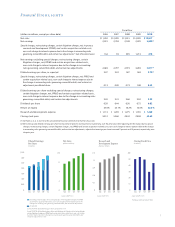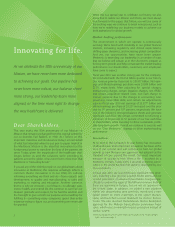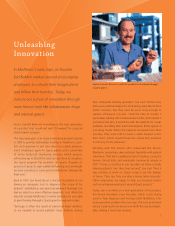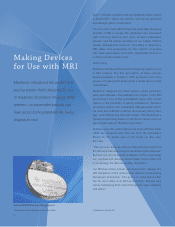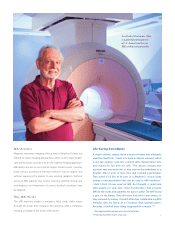Medtronic 2010 Annual Report Download - page 11
Download and view the complete annual report
Please find page 11 of the 2010 Medtronic annual report below. You can navigate through the pages in the report by either clicking on the pages listed below, or by using the keyword search tool below to find specific information within the annual report.
MR I B ene f it s
Magnetic resonance imaging offers a level of detail and clarity not
offered by other imaging approaches, which is why many health-
care professionals consider it to be the optimal imaging approach.
MRI allows doctors to see internal organs, blood vessels, muscles,
joints, tumors, and areas of infection without X-rays or surgery, and
without exposing the patient to any ionizing radiation. Without
access to MRI, patients may not be receiving optimal clinical care,
and diagnosis and treatment of serious medical conditions may
be delayed.
How M R I Work s
The MRI machine creates a magnetic field, sends radio waves
through the body, then measures the response with a computer,
creating an image of the inside of the body.
Len Reed of Cincinnati, Ohio,
is a grateful participant in
a U.S. clinical trial for our
MR-conditional pacemaker.
Life-Saving Serendipity
A simple cataract surgery led to a series of events that ultimately
saved Len Reed’s life. “I went in to have a cataract removed, which
is just day surgery,” said Len, a retired sales representative who
now travels for fun with his wife. “The doctors noticed that
my heart rate was quite low, so they took me by ambulance to a
hospital. After a series of tests, they said I needed a pacemaker.
They asked if I’d like to be part of a Medtronic clinical study
testing a new pacemaker that can be used in MRI machines.*
I didn’t think I’d ever need an MRI, but thought it could help
other people, so I said, ‘Sure.’ A few months later, I had a routine
MRI for the study and suddenly my doctor called. The MRI found
a spot on my kidney. They did more tests and it was cancer, so
they removed my kidney. A month after that, I celebrated my 80th
birthday with my family at a Cincinnati Reds baseball game.
Amazing. I think all those things happened for a reason.”**
*Not approved for marketing in the United States.
**Individual patient results may vary. 7





